Australian Superannuation System Essay
VerifiedAdded on 2019/11/25
|11
|2617
|148
Essay
AI Summary
This essay analyzes Australia's superannuation system, examining whether it disproportionately favors the wealthy. It refutes the common misconception that superannuation doesn't reduce government age pension spending, citing data showing significant annual savings. While acknowledging that high-income earners benefit from certain tax concessions, the essay argues that government assistance for retirement is broadly comparable across income brackets, differing mainly in delivery methods (age pension vs. superannuation tax concessions). It highlights that middle-income earners receive the largest share of superannuation tax concessions. The essay concludes with recommendations for improving the system's equity and sustainability, including adjusting policies to better align with its goals, setting a younger preservation age, and applying the superannuation guarantee to income replacement payments. The importance of policy consistency and the principle of adequacy in retirement income are also emphasized.
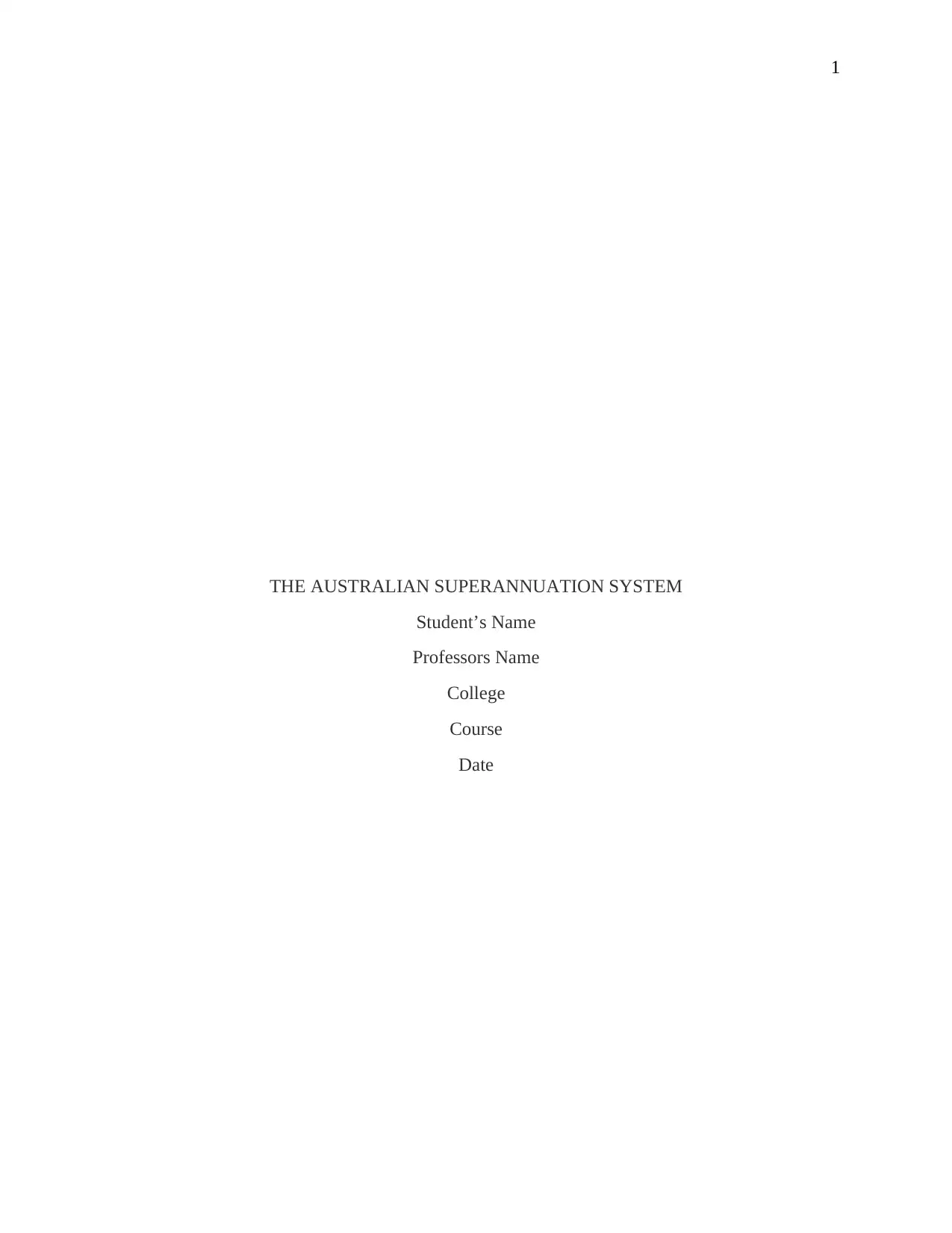
1
THE AUSTRALIAN SUPERANNUATION SYSTEM
Student’s Name
Professors Name
College
Course
Date
THE AUSTRALIAN SUPERANNUATION SYSTEM
Student’s Name
Professors Name
College
Course
Date
Paraphrase This Document
Need a fresh take? Get an instant paraphrase of this document with our AI Paraphraser
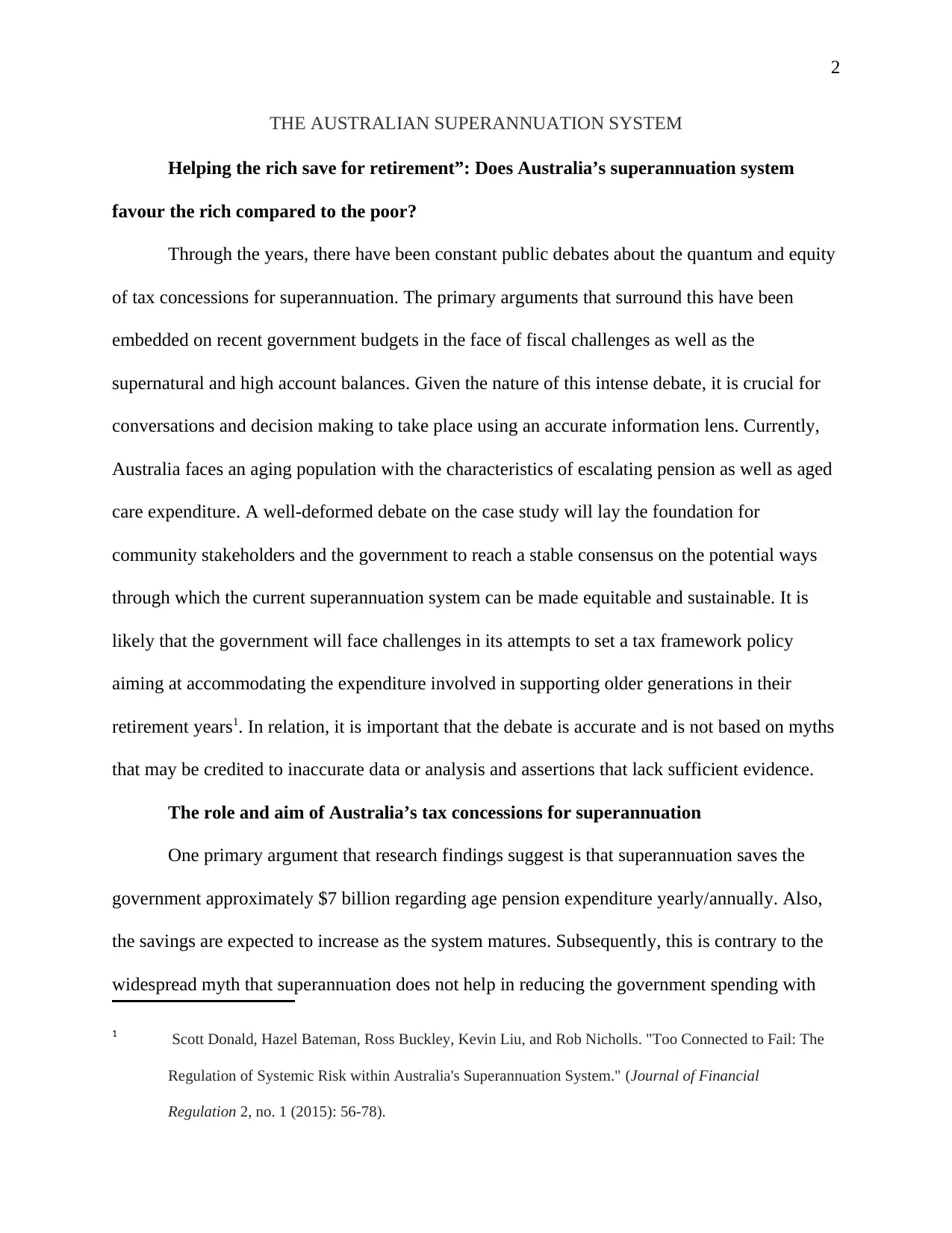
2
THE AUSTRALIAN SUPERANNUATION SYSTEM
Helping the rich save for retirement”: Does Australia’s superannuation system
favour the rich compared to the poor?
Through the years, there have been constant public debates about the quantum and equity
of tax concessions for superannuation. The primary arguments that surround this have been
embedded on recent government budgets in the face of fiscal challenges as well as the
supernatural and high account balances. Given the nature of this intense debate, it is crucial for
conversations and decision making to take place using an accurate information lens. Currently,
Australia faces an aging population with the characteristics of escalating pension as well as aged
care expenditure. A well-deformed debate on the case study will lay the foundation for
community stakeholders and the government to reach a stable consensus on the potential ways
through which the current superannuation system can be made equitable and sustainable. It is
likely that the government will face challenges in its attempts to set a tax framework policy
aiming at accommodating the expenditure involved in supporting older generations in their
retirement years1. In relation, it is important that the debate is accurate and is not based on myths
that may be credited to inaccurate data or analysis and assertions that lack sufficient evidence.
The role and aim of Australia’s tax concessions for superannuation
One primary argument that research findings suggest is that superannuation saves the
government approximately $7 billion regarding age pension expenditure yearly/annually. Also,
the savings are expected to increase as the system matures. Subsequently, this is contrary to the
widespread myth that superannuation does not help in reducing the government spending with
1 Scott Donald, Hazel Bateman, Ross Buckley, Kevin Liu, and Rob Nicholls. "Too Connected to Fail: The
Regulation of Systemic Risk within Australia's Superannuation System." (Journal of Financial
Regulation 2, no. 1 (2015): 56-78).
THE AUSTRALIAN SUPERANNUATION SYSTEM
Helping the rich save for retirement”: Does Australia’s superannuation system
favour the rich compared to the poor?
Through the years, there have been constant public debates about the quantum and equity
of tax concessions for superannuation. The primary arguments that surround this have been
embedded on recent government budgets in the face of fiscal challenges as well as the
supernatural and high account balances. Given the nature of this intense debate, it is crucial for
conversations and decision making to take place using an accurate information lens. Currently,
Australia faces an aging population with the characteristics of escalating pension as well as aged
care expenditure. A well-deformed debate on the case study will lay the foundation for
community stakeholders and the government to reach a stable consensus on the potential ways
through which the current superannuation system can be made equitable and sustainable. It is
likely that the government will face challenges in its attempts to set a tax framework policy
aiming at accommodating the expenditure involved in supporting older generations in their
retirement years1. In relation, it is important that the debate is accurate and is not based on myths
that may be credited to inaccurate data or analysis and assertions that lack sufficient evidence.
The role and aim of Australia’s tax concessions for superannuation
One primary argument that research findings suggest is that superannuation saves the
government approximately $7 billion regarding age pension expenditure yearly/annually. Also,
the savings are expected to increase as the system matures. Subsequently, this is contrary to the
widespread myth that superannuation does not help in reducing the government spending with
1 Scott Donald, Hazel Bateman, Ross Buckley, Kevin Liu, and Rob Nicholls. "Too Connected to Fail: The
Regulation of Systemic Risk within Australia's Superannuation System." (Journal of Financial
Regulation 2, no. 1 (2015): 56-78).
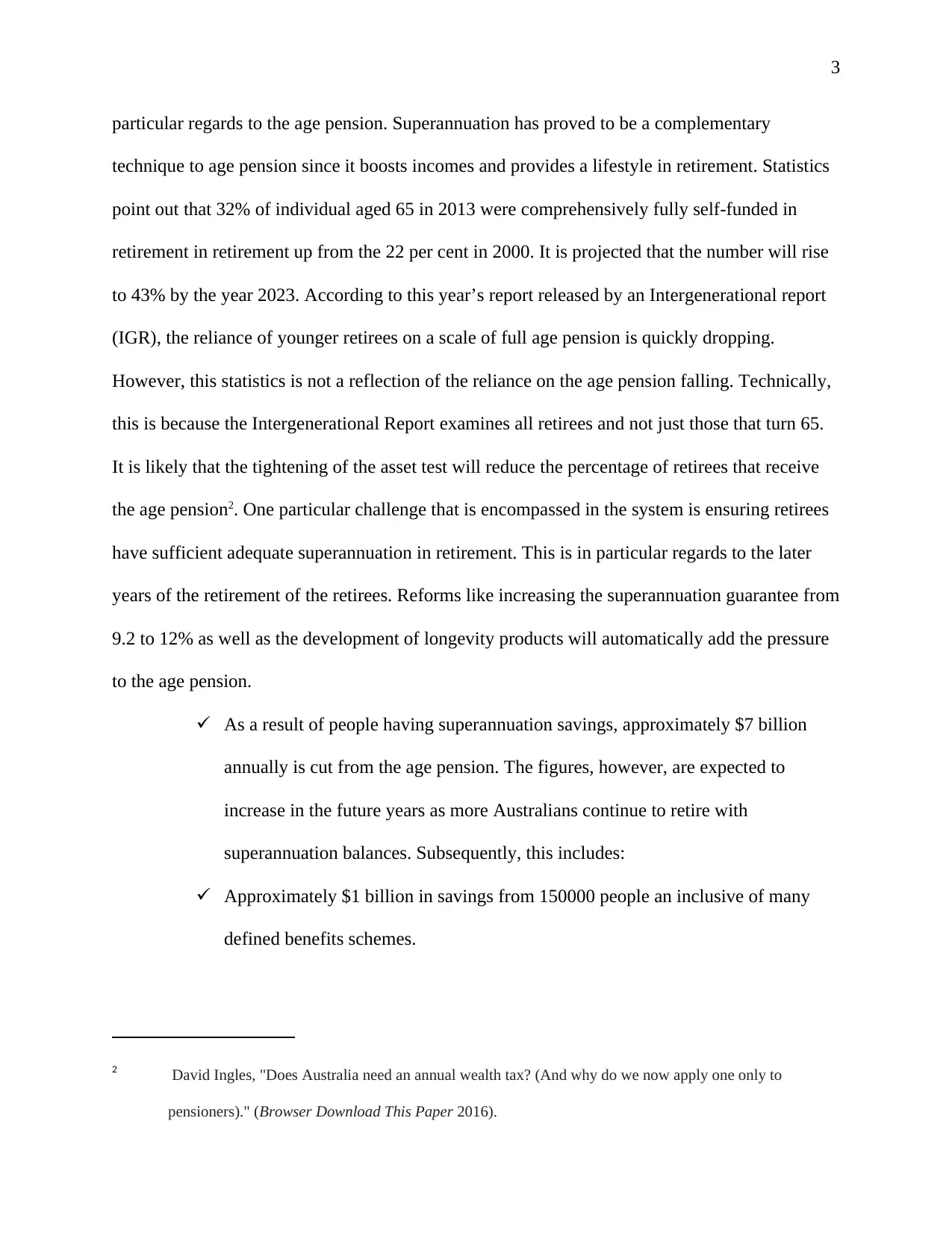
3
particular regards to the age pension. Superannuation has proved to be a complementary
technique to age pension since it boosts incomes and provides a lifestyle in retirement. Statistics
point out that 32% of individual aged 65 in 2013 were comprehensively fully self-funded in
retirement in retirement up from the 22 per cent in 2000. It is projected that the number will rise
to 43% by the year 2023. According to this year’s report released by an Intergenerational report
(IGR), the reliance of younger retirees on a scale of full age pension is quickly dropping.
However, this statistics is not a reflection of the reliance on the age pension falling. Technically,
this is because the Intergenerational Report examines all retirees and not just those that turn 65.
It is likely that the tightening of the asset test will reduce the percentage of retirees that receive
the age pension2. One particular challenge that is encompassed in the system is ensuring retirees
have sufficient adequate superannuation in retirement. This is in particular regards to the later
years of the retirement of the retirees. Reforms like increasing the superannuation guarantee from
9.2 to 12% as well as the development of longevity products will automatically add the pressure
to the age pension.
As a result of people having superannuation savings, approximately $7 billion
annually is cut from the age pension. The figures, however, are expected to
increase in the future years as more Australians continue to retire with
superannuation balances. Subsequently, this includes:
Approximately $1 billion in savings from 150000 people an inclusive of many
defined benefits schemes.
2 David Ingles, "Does Australia need an annual wealth tax? (And why do we now apply one only to
pensioners)." (Browser Download This Paper 2016).
particular regards to the age pension. Superannuation has proved to be a complementary
technique to age pension since it boosts incomes and provides a lifestyle in retirement. Statistics
point out that 32% of individual aged 65 in 2013 were comprehensively fully self-funded in
retirement in retirement up from the 22 per cent in 2000. It is projected that the number will rise
to 43% by the year 2023. According to this year’s report released by an Intergenerational report
(IGR), the reliance of younger retirees on a scale of full age pension is quickly dropping.
However, this statistics is not a reflection of the reliance on the age pension falling. Technically,
this is because the Intergenerational Report examines all retirees and not just those that turn 65.
It is likely that the tightening of the asset test will reduce the percentage of retirees that receive
the age pension2. One particular challenge that is encompassed in the system is ensuring retirees
have sufficient adequate superannuation in retirement. This is in particular regards to the later
years of the retirement of the retirees. Reforms like increasing the superannuation guarantee from
9.2 to 12% as well as the development of longevity products will automatically add the pressure
to the age pension.
As a result of people having superannuation savings, approximately $7 billion
annually is cut from the age pension. The figures, however, are expected to
increase in the future years as more Australians continue to retire with
superannuation balances. Subsequently, this includes:
Approximately $1 billion in savings from 150000 people an inclusive of many
defined benefits schemes.
2 David Ingles, "Does Australia need an annual wealth tax? (And why do we now apply one only to
pensioners)." (Browser Download This Paper 2016).
⊘ This is a preview!⊘
Do you want full access?
Subscribe today to unlock all pages.

Trusted by 1+ million students worldwide
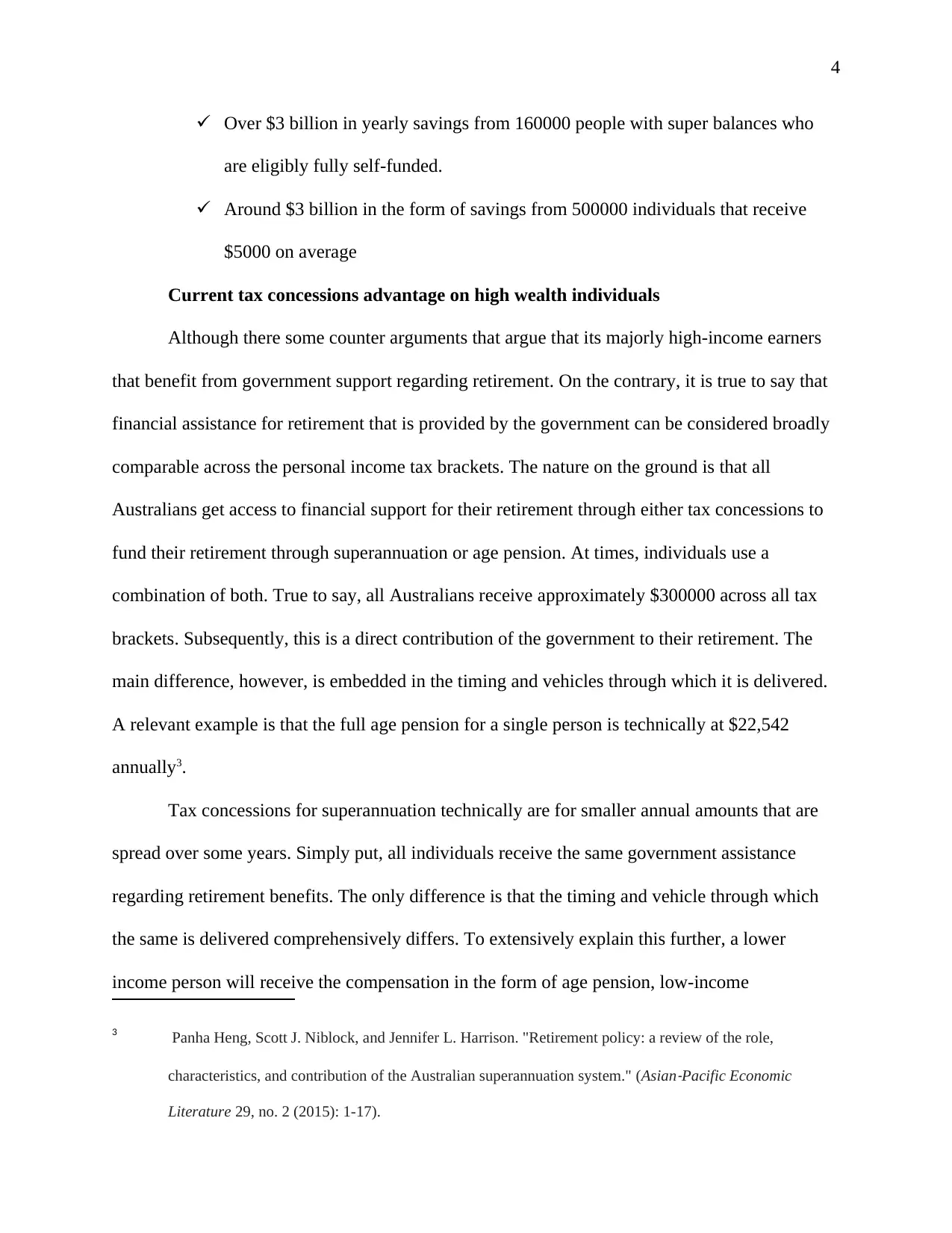
4
Over $3 billion in yearly savings from 160000 people with super balances who
are eligibly fully self-funded.
Around $3 billion in the form of savings from 500000 individuals that receive
$5000 on average
Current tax concessions advantage on high wealth individuals
Although there some counter arguments that argue that its majorly high-income earners
that benefit from government support regarding retirement. On the contrary, it is true to say that
financial assistance for retirement that is provided by the government can be considered broadly
comparable across the personal income tax brackets. The nature on the ground is that all
Australians get access to financial support for their retirement through either tax concessions to
fund their retirement through superannuation or age pension. At times, individuals use a
combination of both. True to say, all Australians receive approximately $300000 across all tax
brackets. Subsequently, this is a direct contribution of the government to their retirement. The
main difference, however, is embedded in the timing and vehicles through which it is delivered.
A relevant example is that the full age pension for a single person is technically at $22,542
annually3.
Tax concessions for superannuation technically are for smaller annual amounts that are
spread over some years. Simply put, all individuals receive the same government assistance
regarding retirement benefits. The only difference is that the timing and vehicle through which
the same is delivered comprehensively differs. To extensively explain this further, a lower
income person will receive the compensation in the form of age pension, low-income
3 Panha Heng, Scott J. Niblock, and Jennifer L. Harrison. "Retirement policy: a review of the role,
characteristics, and contribution of the Australian superannuation system." (Asian
‐Pacific Economic
Literature 29, no. 2 (2015): 1-17).
Over $3 billion in yearly savings from 160000 people with super balances who
are eligibly fully self-funded.
Around $3 billion in the form of savings from 500000 individuals that receive
$5000 on average
Current tax concessions advantage on high wealth individuals
Although there some counter arguments that argue that its majorly high-income earners
that benefit from government support regarding retirement. On the contrary, it is true to say that
financial assistance for retirement that is provided by the government can be considered broadly
comparable across the personal income tax brackets. The nature on the ground is that all
Australians get access to financial support for their retirement through either tax concessions to
fund their retirement through superannuation or age pension. At times, individuals use a
combination of both. True to say, all Australians receive approximately $300000 across all tax
brackets. Subsequently, this is a direct contribution of the government to their retirement. The
main difference, however, is embedded in the timing and vehicles through which it is delivered.
A relevant example is that the full age pension for a single person is technically at $22,542
annually3.
Tax concessions for superannuation technically are for smaller annual amounts that are
spread over some years. Simply put, all individuals receive the same government assistance
regarding retirement benefits. The only difference is that the timing and vehicle through which
the same is delivered comprehensively differs. To extensively explain this further, a lower
income person will receive the compensation in the form of age pension, low-income
3 Panha Heng, Scott J. Niblock, and Jennifer L. Harrison. "Retirement policy: a review of the role,
characteristics, and contribution of the Australian superannuation system." (Asian
‐Pacific Economic
Literature 29, no. 2 (2015): 1-17).
Paraphrase This Document
Need a fresh take? Get an instant paraphrase of this document with our AI Paraphraser
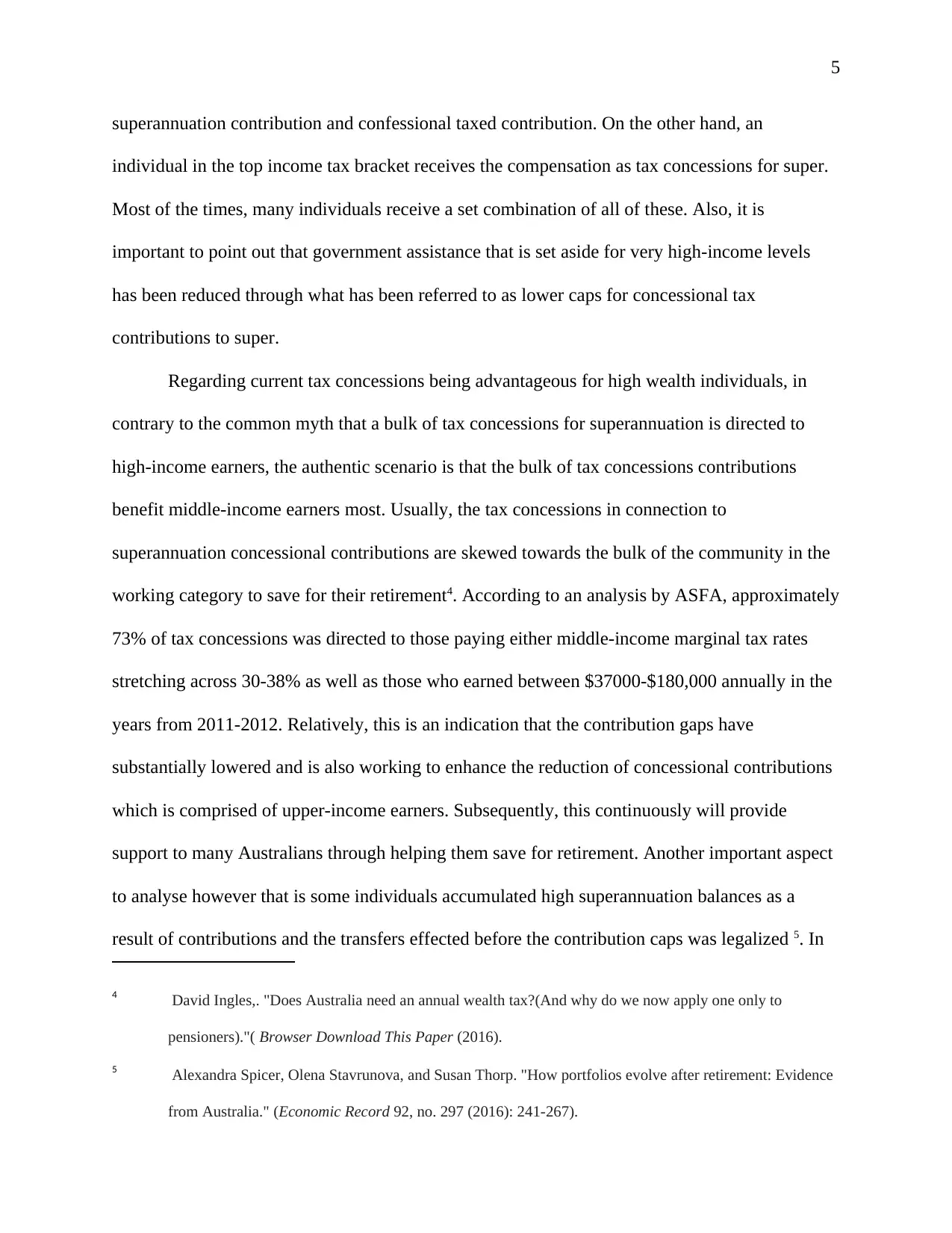
5
superannuation contribution and confessional taxed contribution. On the other hand, an
individual in the top income tax bracket receives the compensation as tax concessions for super.
Most of the times, many individuals receive a set combination of all of these. Also, it is
important to point out that government assistance that is set aside for very high-income levels
has been reduced through what has been referred to as lower caps for concessional tax
contributions to super.
Regarding current tax concessions being advantageous for high wealth individuals, in
contrary to the common myth that a bulk of tax concessions for superannuation is directed to
high-income earners, the authentic scenario is that the bulk of tax concessions contributions
benefit middle-income earners most. Usually, the tax concessions in connection to
superannuation concessional contributions are skewed towards the bulk of the community in the
working category to save for their retirement4. According to an analysis by ASFA, approximately
73% of tax concessions was directed to those paying either middle-income marginal tax rates
stretching across 30-38% as well as those who earned between $37000-$180,000 annually in the
years from 2011-2012. Relatively, this is an indication that the contribution gaps have
substantially lowered and is also working to enhance the reduction of concessional contributions
which is comprised of upper-income earners. Subsequently, this continuously will provide
support to many Australians through helping them save for retirement. Another important aspect
to analyse however that is some individuals accumulated high superannuation balances as a
result of contributions and the transfers effected before the contribution caps was legalized 5. In
4 David Ingles,. "Does Australia need an annual wealth tax?(And why do we now apply one only to
pensioners)."( Browser Download This Paper (2016).
5 Alexandra Spicer, Olena Stavrunova, and Susan Thorp. "How portfolios evolve after retirement: Evidence
from Australia." (Economic Record 92, no. 297 (2016): 241-267).
superannuation contribution and confessional taxed contribution. On the other hand, an
individual in the top income tax bracket receives the compensation as tax concessions for super.
Most of the times, many individuals receive a set combination of all of these. Also, it is
important to point out that government assistance that is set aside for very high-income levels
has been reduced through what has been referred to as lower caps for concessional tax
contributions to super.
Regarding current tax concessions being advantageous for high wealth individuals, in
contrary to the common myth that a bulk of tax concessions for superannuation is directed to
high-income earners, the authentic scenario is that the bulk of tax concessions contributions
benefit middle-income earners most. Usually, the tax concessions in connection to
superannuation concessional contributions are skewed towards the bulk of the community in the
working category to save for their retirement4. According to an analysis by ASFA, approximately
73% of tax concessions was directed to those paying either middle-income marginal tax rates
stretching across 30-38% as well as those who earned between $37000-$180,000 annually in the
years from 2011-2012. Relatively, this is an indication that the contribution gaps have
substantially lowered and is also working to enhance the reduction of concessional contributions
which is comprised of upper-income earners. Subsequently, this continuously will provide
support to many Australians through helping them save for retirement. Another important aspect
to analyse however that is some individuals accumulated high superannuation balances as a
result of contributions and the transfers effected before the contribution caps was legalized 5. In
4 David Ingles,. "Does Australia need an annual wealth tax?(And why do we now apply one only to
pensioners)."( Browser Download This Paper (2016).
5 Alexandra Spicer, Olena Stavrunova, and Susan Thorp. "How portfolios evolve after retirement: Evidence
from Australia." (Economic Record 92, no. 297 (2016): 241-267).
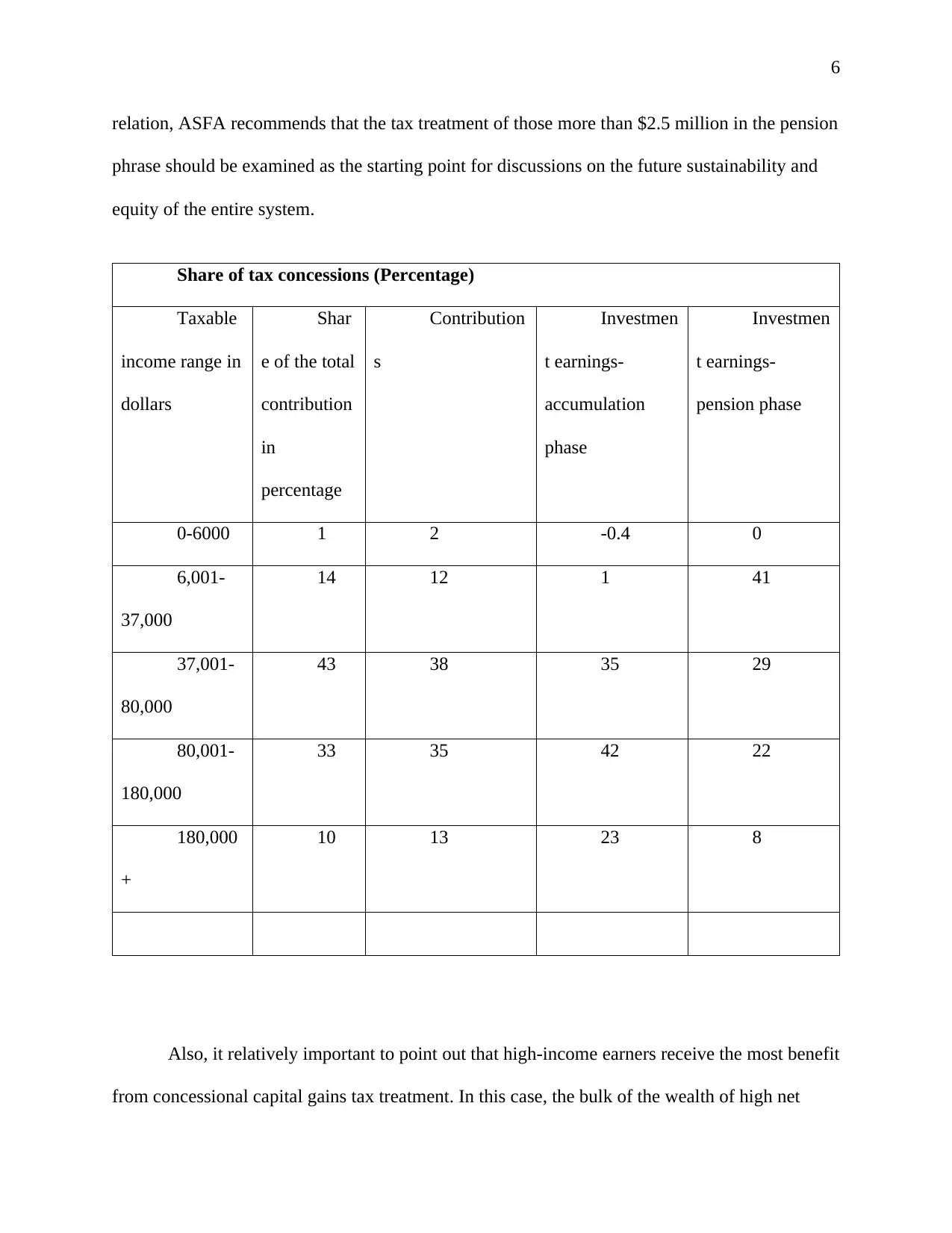
6
relation, ASFA recommends that the tax treatment of those more than $2.5 million in the pension
phrase should be examined as the starting point for discussions on the future sustainability and
equity of the entire system.
Share of tax concessions (Percentage)
Taxable
income range in
dollars
Shar
e of the total
contribution
in
percentage
Contribution
s
Investmen
t earnings-
accumulation
phase
Investmen
t earnings-
pension phase
0-6000 1 2 -0.4 0
6,001-
37,000
14 12 1 41
37,001-
80,000
43 38 35 29
80,001-
180,000
33 35 42 22
180,000
+
10 13 23 8
Also, it relatively important to point out that high-income earners receive the most benefit
from concessional capital gains tax treatment. In this case, the bulk of the wealth of high net
relation, ASFA recommends that the tax treatment of those more than $2.5 million in the pension
phrase should be examined as the starting point for discussions on the future sustainability and
equity of the entire system.
Share of tax concessions (Percentage)
Taxable
income range in
dollars
Shar
e of the total
contribution
in
percentage
Contribution
s
Investmen
t earnings-
accumulation
phase
Investmen
t earnings-
pension phase
0-6000 1 2 -0.4 0
6,001-
37,000
14 12 1 41
37,001-
80,000
43 38 35 29
80,001-
180,000
33 35 42 22
180,000
+
10 13 23 8
Also, it relatively important to point out that high-income earners receive the most benefit
from concessional capital gains tax treatment. In this case, the bulk of the wealth of high net
⊘ This is a preview!⊘
Do you want full access?
Subscribe today to unlock all pages.

Trusted by 1+ million students worldwide
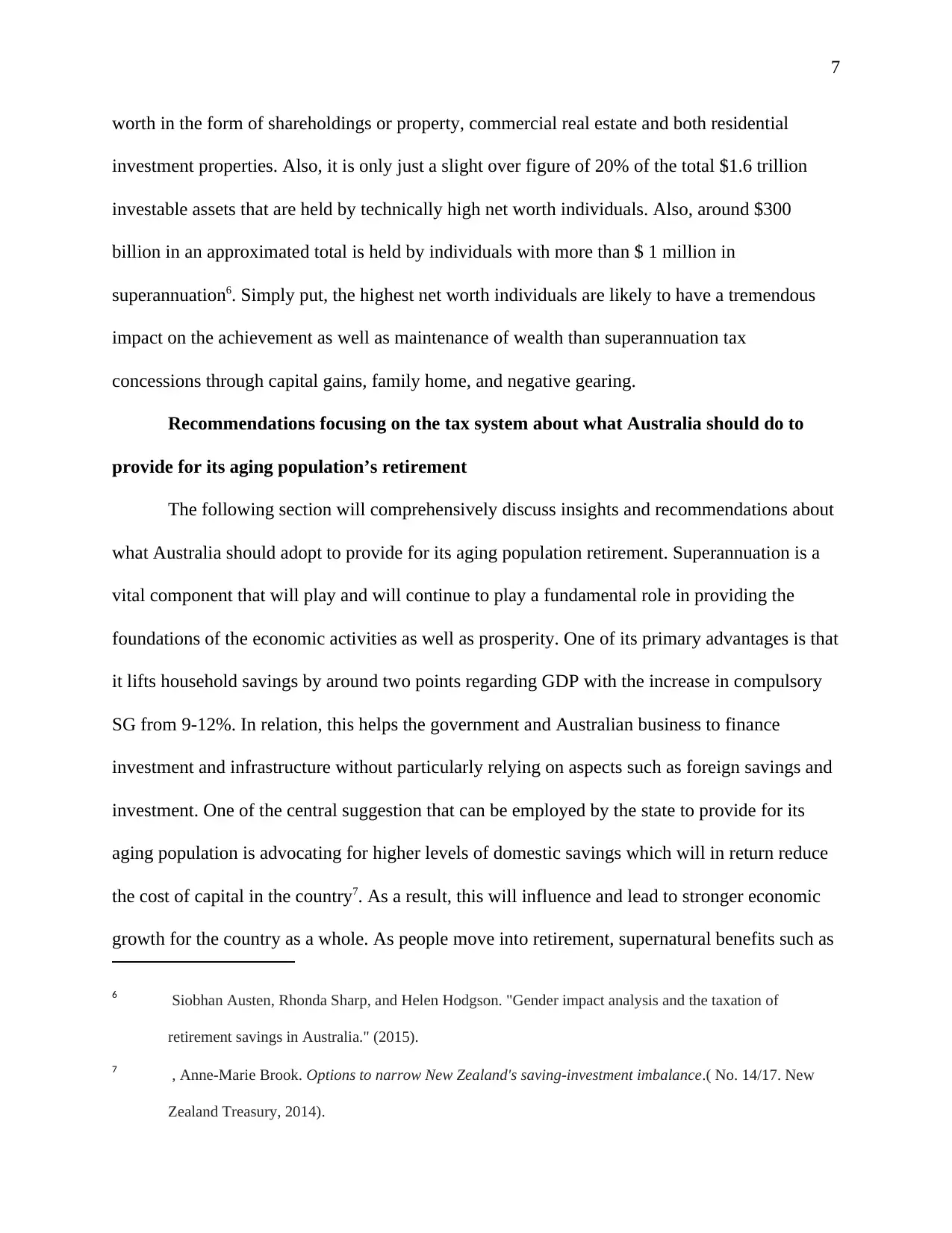
7
worth in the form of shareholdings or property, commercial real estate and both residential
investment properties. Also, it is only just a slight over figure of 20% of the total $1.6 trillion
investable assets that are held by technically high net worth individuals. Also, around $300
billion in an approximated total is held by individuals with more than $ 1 million in
superannuation6. Simply put, the highest net worth individuals are likely to have a tremendous
impact on the achievement as well as maintenance of wealth than superannuation tax
concessions through capital gains, family home, and negative gearing.
Recommendations focusing on the tax system about what Australia should do to
provide for its aging population’s retirement
The following section will comprehensively discuss insights and recommendations about
what Australia should adopt to provide for its aging population retirement. Superannuation is a
vital component that will play and will continue to play a fundamental role in providing the
foundations of the economic activities as well as prosperity. One of its primary advantages is that
it lifts household savings by around two points regarding GDP with the increase in compulsory
SG from 9-12%. In relation, this helps the government and Australian business to finance
investment and infrastructure without particularly relying on aspects such as foreign savings and
investment. One of the central suggestion that can be employed by the state to provide for its
aging population is advocating for higher levels of domestic savings which will in return reduce
the cost of capital in the country7. As a result, this will influence and lead to stronger economic
growth for the country as a whole. As people move into retirement, supernatural benefits such as
6 Siobhan Austen, Rhonda Sharp, and Helen Hodgson. "Gender impact analysis and the taxation of
retirement savings in Australia." (2015).
7 , Anne-Marie Brook. Options to narrow New Zealand's saving-investment imbalance.( No. 14/17. New
Zealand Treasury, 2014).
worth in the form of shareholdings or property, commercial real estate and both residential
investment properties. Also, it is only just a slight over figure of 20% of the total $1.6 trillion
investable assets that are held by technically high net worth individuals. Also, around $300
billion in an approximated total is held by individuals with more than $ 1 million in
superannuation6. Simply put, the highest net worth individuals are likely to have a tremendous
impact on the achievement as well as maintenance of wealth than superannuation tax
concessions through capital gains, family home, and negative gearing.
Recommendations focusing on the tax system about what Australia should do to
provide for its aging population’s retirement
The following section will comprehensively discuss insights and recommendations about
what Australia should adopt to provide for its aging population retirement. Superannuation is a
vital component that will play and will continue to play a fundamental role in providing the
foundations of the economic activities as well as prosperity. One of its primary advantages is that
it lifts household savings by around two points regarding GDP with the increase in compulsory
SG from 9-12%. In relation, this helps the government and Australian business to finance
investment and infrastructure without particularly relying on aspects such as foreign savings and
investment. One of the central suggestion that can be employed by the state to provide for its
aging population is advocating for higher levels of domestic savings which will in return reduce
the cost of capital in the country7. As a result, this will influence and lead to stronger economic
growth for the country as a whole. As people move into retirement, supernatural benefits such as
6 Siobhan Austen, Rhonda Sharp, and Helen Hodgson. "Gender impact analysis and the taxation of
retirement savings in Australia." (2015).
7 , Anne-Marie Brook. Options to narrow New Zealand's saving-investment imbalance.( No. 14/17. New
Zealand Treasury, 2014).
Paraphrase This Document
Need a fresh take? Get an instant paraphrase of this document with our AI Paraphraser
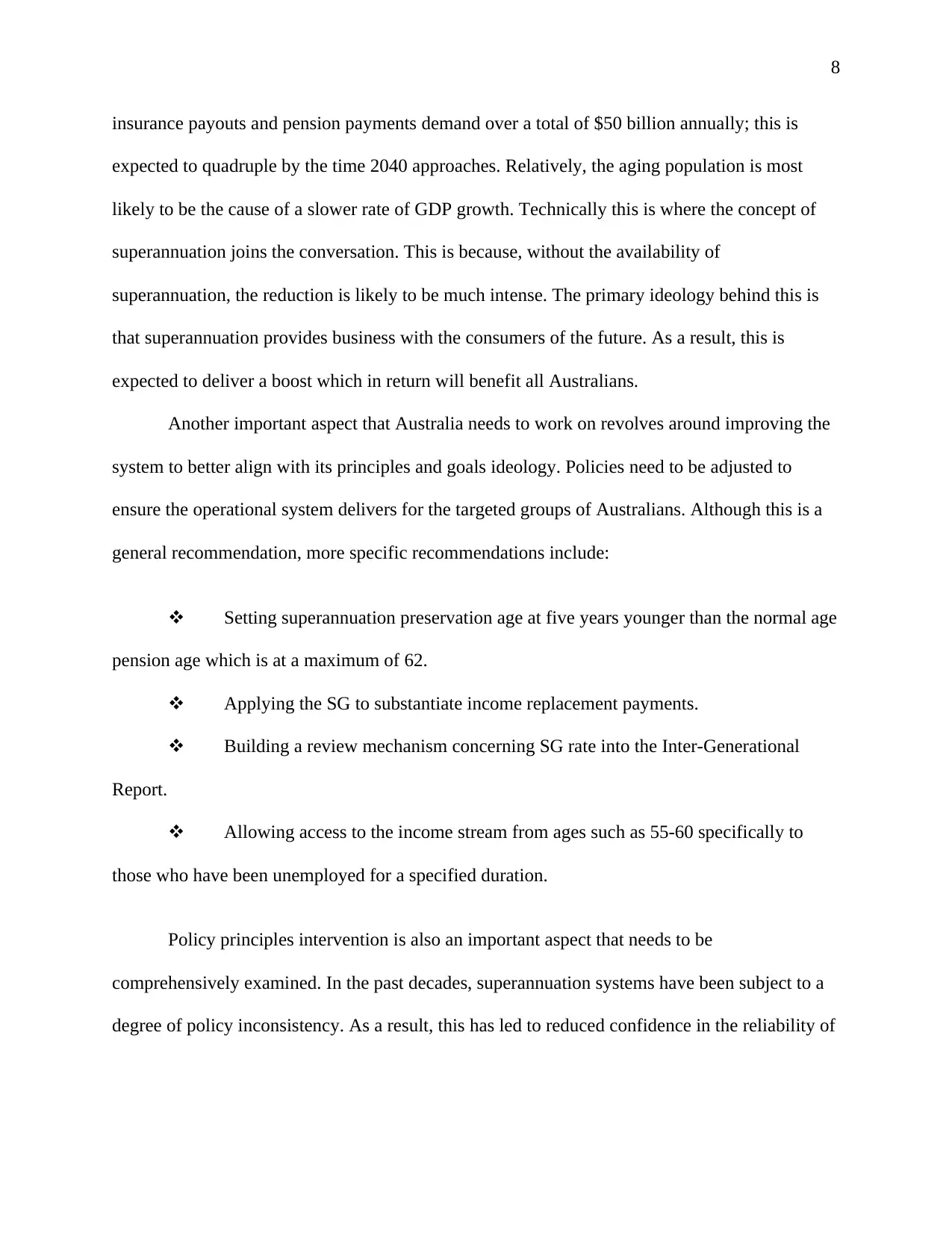
8
insurance payouts and pension payments demand over a total of $50 billion annually; this is
expected to quadruple by the time 2040 approaches. Relatively, the aging population is most
likely to be the cause of a slower rate of GDP growth. Technically this is where the concept of
superannuation joins the conversation. This is because, without the availability of
superannuation, the reduction is likely to be much intense. The primary ideology behind this is
that superannuation provides business with the consumers of the future. As a result, this is
expected to deliver a boost which in return will benefit all Australians.
Another important aspect that Australia needs to work on revolves around improving the
system to better align with its principles and goals ideology. Policies need to be adjusted to
ensure the operational system delivers for the targeted groups of Australians. Although this is a
general recommendation, more specific recommendations include:
Setting superannuation preservation age at five years younger than the normal age
pension age which is at a maximum of 62.
Applying the SG to substantiate income replacement payments.
Building a review mechanism concerning SG rate into the Inter-Generational
Report.
Allowing access to the income stream from ages such as 55-60 specifically to
those who have been unemployed for a specified duration.
Policy principles intervention is also an important aspect that needs to be
comprehensively examined. In the past decades, superannuation systems have been subject to a
degree of policy inconsistency. As a result, this has led to reduced confidence in the reliability of
insurance payouts and pension payments demand over a total of $50 billion annually; this is
expected to quadruple by the time 2040 approaches. Relatively, the aging population is most
likely to be the cause of a slower rate of GDP growth. Technically this is where the concept of
superannuation joins the conversation. This is because, without the availability of
superannuation, the reduction is likely to be much intense. The primary ideology behind this is
that superannuation provides business with the consumers of the future. As a result, this is
expected to deliver a boost which in return will benefit all Australians.
Another important aspect that Australia needs to work on revolves around improving the
system to better align with its principles and goals ideology. Policies need to be adjusted to
ensure the operational system delivers for the targeted groups of Australians. Although this is a
general recommendation, more specific recommendations include:
Setting superannuation preservation age at five years younger than the normal age
pension age which is at a maximum of 62.
Applying the SG to substantiate income replacement payments.
Building a review mechanism concerning SG rate into the Inter-Generational
Report.
Allowing access to the income stream from ages such as 55-60 specifically to
those who have been unemployed for a specified duration.
Policy principles intervention is also an important aspect that needs to be
comprehensively examined. In the past decades, superannuation systems have been subject to a
degree of policy inconsistency. As a result, this has led to reduced confidence in the reliability of
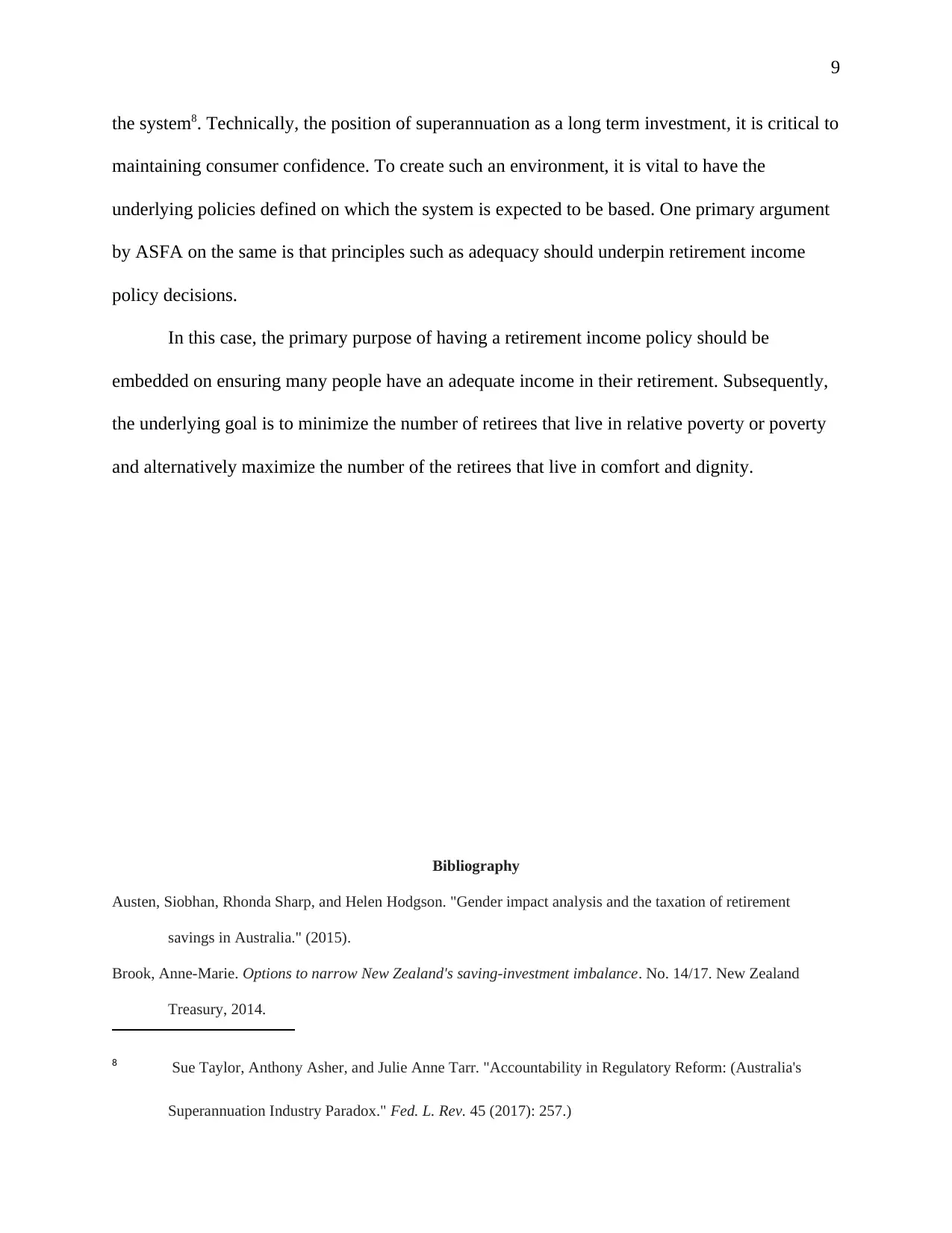
9
the system8. Technically, the position of superannuation as a long term investment, it is critical to
maintaining consumer confidence. To create such an environment, it is vital to have the
underlying policies defined on which the system is expected to be based. One primary argument
by ASFA on the same is that principles such as adequacy should underpin retirement income
policy decisions.
In this case, the primary purpose of having a retirement income policy should be
embedded on ensuring many people have an adequate income in their retirement. Subsequently,
the underlying goal is to minimize the number of retirees that live in relative poverty or poverty
and alternatively maximize the number of the retirees that live in comfort and dignity.
Bibliography
Austen, Siobhan, Rhonda Sharp, and Helen Hodgson. "Gender impact analysis and the taxation of retirement
savings in Australia." (2015).
Brook, Anne-Marie. Options to narrow New Zealand's saving-investment imbalance. No. 14/17. New Zealand
Treasury, 2014.
8 Sue Taylor, Anthony Asher, and Julie Anne Tarr. "Accountability in Regulatory Reform: (Australia's
Superannuation Industry Paradox." Fed. L. Rev. 45 (2017): 257.)
the system8. Technically, the position of superannuation as a long term investment, it is critical to
maintaining consumer confidence. To create such an environment, it is vital to have the
underlying policies defined on which the system is expected to be based. One primary argument
by ASFA on the same is that principles such as adequacy should underpin retirement income
policy decisions.
In this case, the primary purpose of having a retirement income policy should be
embedded on ensuring many people have an adequate income in their retirement. Subsequently,
the underlying goal is to minimize the number of retirees that live in relative poverty or poverty
and alternatively maximize the number of the retirees that live in comfort and dignity.
Bibliography
Austen, Siobhan, Rhonda Sharp, and Helen Hodgson. "Gender impact analysis and the taxation of retirement
savings in Australia." (2015).
Brook, Anne-Marie. Options to narrow New Zealand's saving-investment imbalance. No. 14/17. New Zealand
Treasury, 2014.
8 Sue Taylor, Anthony Asher, and Julie Anne Tarr. "Accountability in Regulatory Reform: (Australia's
Superannuation Industry Paradox." Fed. L. Rev. 45 (2017): 257.)
⊘ This is a preview!⊘
Do you want full access?
Subscribe today to unlock all pages.

Trusted by 1+ million students worldwide
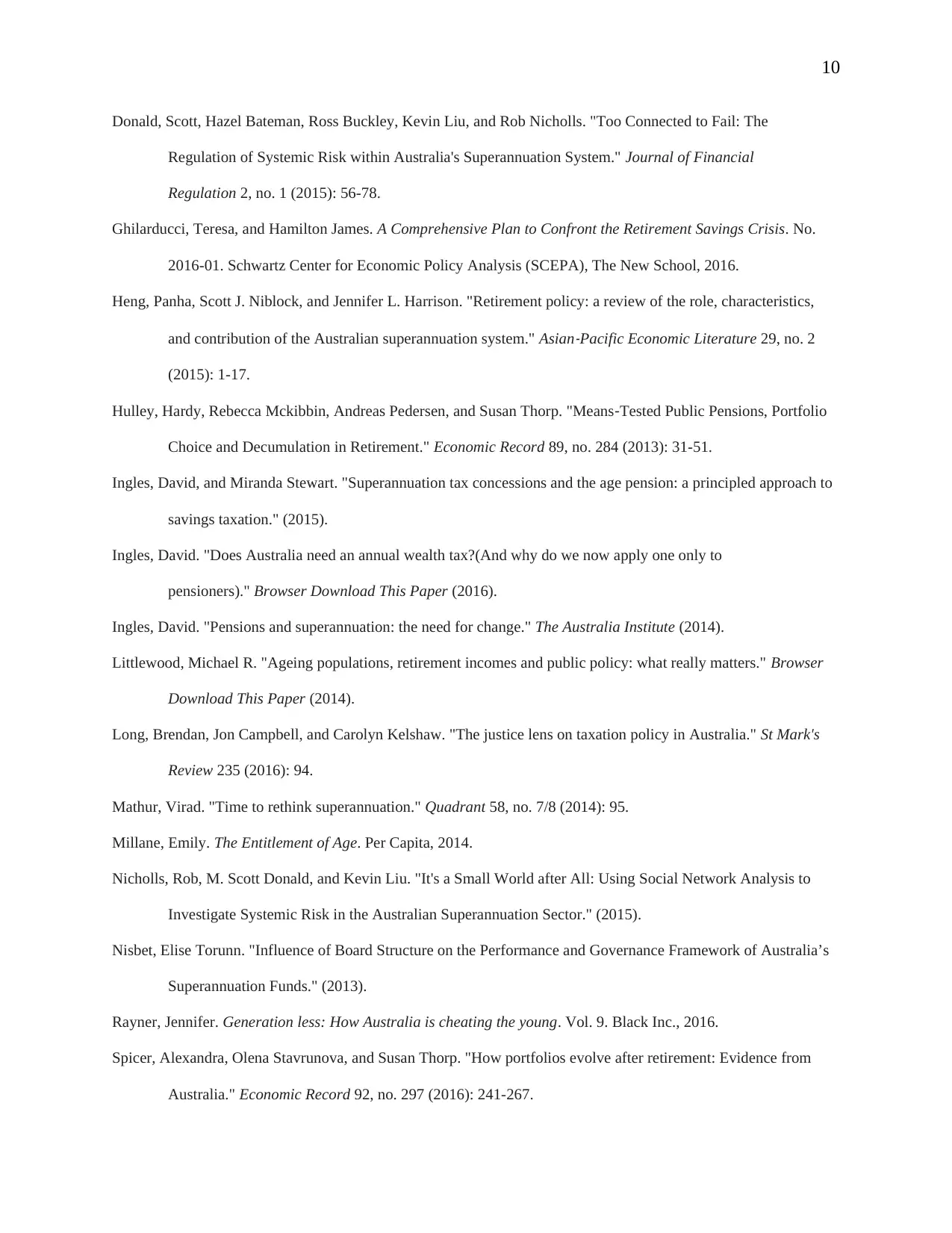
10
Donald, Scott, Hazel Bateman, Ross Buckley, Kevin Liu, and Rob Nicholls. "Too Connected to Fail: The
Regulation of Systemic Risk within Australia's Superannuation System." Journal of Financial
Regulation 2, no. 1 (2015): 56-78.
Ghilarducci, Teresa, and Hamilton James. A Comprehensive Plan to Confront the Retirement Savings Crisis. No.
2016-01. Schwartz Center for Economic Policy Analysis (SCEPA), The New School, 2016.
Heng, Panha, Scott J. Niblock, and Jennifer L. Harrison. "Retirement policy: a review of the role, characteristics,
and contribution of the Australian superannuation system." Asian
‐Pacific Economic Literature 29, no. 2
(2015): 1-17.
Hulley, Hardy, Rebecca Mckibbin, Andreas Pedersen, and Susan Thorp. "Means‐Tested Public Pensions, Portfolio
Choice and Decumulation in Retirement." Economic Record 89, no. 284 (2013): 31-51.
Ingles, David, and Miranda Stewart. "Superannuation tax concessions and the age pension: a principled approach to
savings taxation." (2015).
Ingles, David. "Does Australia need an annual wealth tax?(And why do we now apply one only to
pensioners)." Browser Download This Paper (2016).
Ingles, David. "Pensions and superannuation: the need for change." The Australia Institute (2014).
Littlewood, Michael R. "Ageing populations, retirement incomes and public policy: what really matters." Browser
Download This Paper (2014).
Long, Brendan, Jon Campbell, and Carolyn Kelshaw. "The justice lens on taxation policy in Australia." St Mark's
Review 235 (2016): 94.
Mathur, Virad. "Time to rethink superannuation." Quadrant 58, no. 7/8 (2014): 95.
Millane, Emily. The Entitlement of Age. Per Capita, 2014.
Nicholls, Rob, M. Scott Donald, and Kevin Liu. "It's a Small World after All: Using Social Network Analysis to
Investigate Systemic Risk in the Australian Superannuation Sector." (2015).
Nisbet, Elise Torunn. "Influence of Board Structure on the Performance and Governance Framework of Australia’s
Superannuation Funds." (2013).
Rayner, Jennifer. Generation less: How Australia is cheating the young. Vol. 9. Black Inc., 2016.
Spicer, Alexandra, Olena Stavrunova, and Susan Thorp. "How portfolios evolve after retirement: Evidence from
Australia." Economic Record 92, no. 297 (2016): 241-267.
Donald, Scott, Hazel Bateman, Ross Buckley, Kevin Liu, and Rob Nicholls. "Too Connected to Fail: The
Regulation of Systemic Risk within Australia's Superannuation System." Journal of Financial
Regulation 2, no. 1 (2015): 56-78.
Ghilarducci, Teresa, and Hamilton James. A Comprehensive Plan to Confront the Retirement Savings Crisis. No.
2016-01. Schwartz Center for Economic Policy Analysis (SCEPA), The New School, 2016.
Heng, Panha, Scott J. Niblock, and Jennifer L. Harrison. "Retirement policy: a review of the role, characteristics,
and contribution of the Australian superannuation system." Asian
‐Pacific Economic Literature 29, no. 2
(2015): 1-17.
Hulley, Hardy, Rebecca Mckibbin, Andreas Pedersen, and Susan Thorp. "Means‐Tested Public Pensions, Portfolio
Choice and Decumulation in Retirement." Economic Record 89, no. 284 (2013): 31-51.
Ingles, David, and Miranda Stewart. "Superannuation tax concessions and the age pension: a principled approach to
savings taxation." (2015).
Ingles, David. "Does Australia need an annual wealth tax?(And why do we now apply one only to
pensioners)." Browser Download This Paper (2016).
Ingles, David. "Pensions and superannuation: the need for change." The Australia Institute (2014).
Littlewood, Michael R. "Ageing populations, retirement incomes and public policy: what really matters." Browser
Download This Paper (2014).
Long, Brendan, Jon Campbell, and Carolyn Kelshaw. "The justice lens on taxation policy in Australia." St Mark's
Review 235 (2016): 94.
Mathur, Virad. "Time to rethink superannuation." Quadrant 58, no. 7/8 (2014): 95.
Millane, Emily. The Entitlement of Age. Per Capita, 2014.
Nicholls, Rob, M. Scott Donald, and Kevin Liu. "It's a Small World after All: Using Social Network Analysis to
Investigate Systemic Risk in the Australian Superannuation Sector." (2015).
Nisbet, Elise Torunn. "Influence of Board Structure on the Performance and Governance Framework of Australia’s
Superannuation Funds." (2013).
Rayner, Jennifer. Generation less: How Australia is cheating the young. Vol. 9. Black Inc., 2016.
Spicer, Alexandra, Olena Stavrunova, and Susan Thorp. "How portfolios evolve after retirement: Evidence from
Australia." Economic Record 92, no. 297 (2016): 241-267.
Paraphrase This Document
Need a fresh take? Get an instant paraphrase of this document with our AI Paraphraser
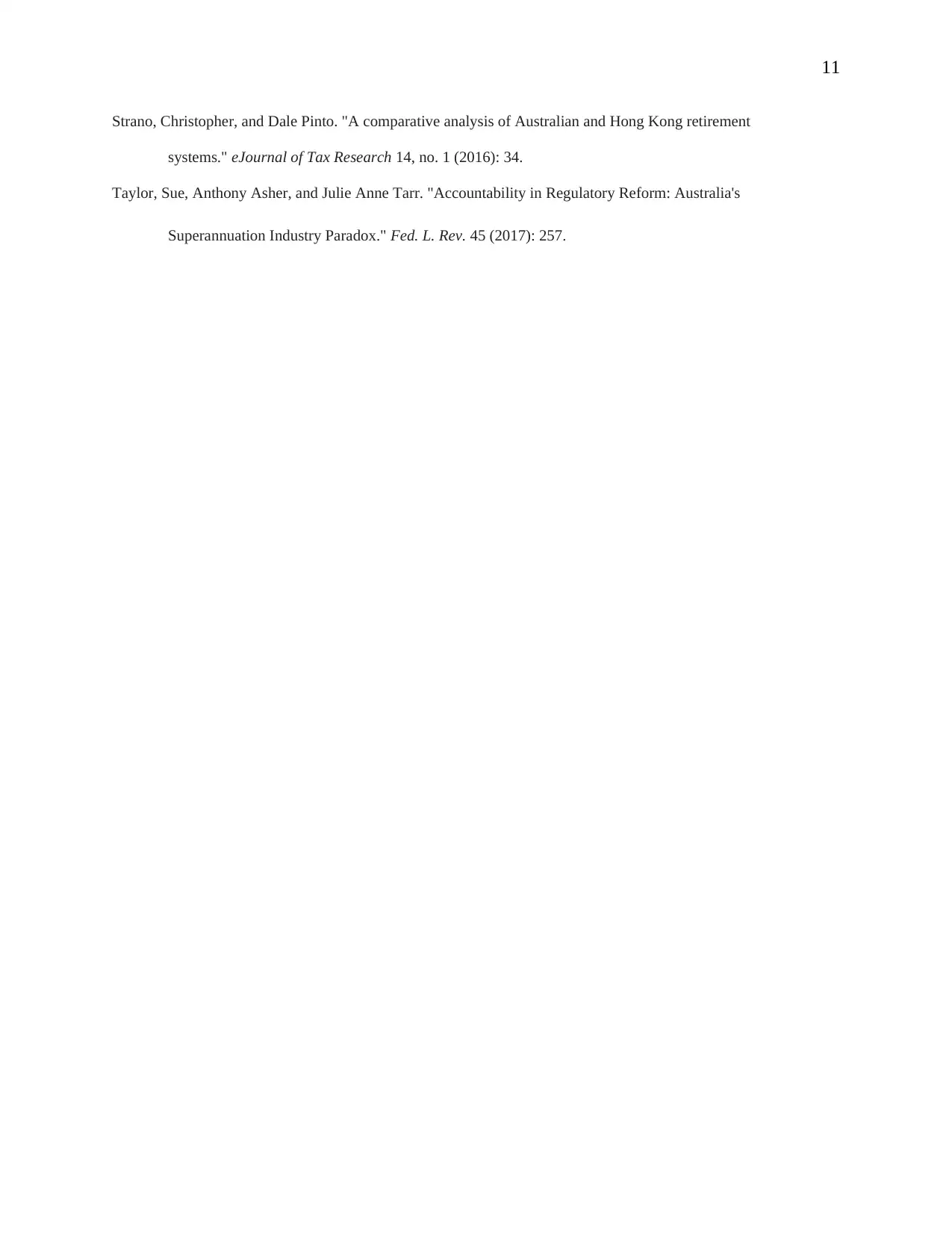
11
Strano, Christopher, and Dale Pinto. "A comparative analysis of Australian and Hong Kong retirement
systems." eJournal of Tax Research 14, no. 1 (2016): 34.
Taylor, Sue, Anthony Asher, and Julie Anne Tarr. "Accountability in Regulatory Reform: Australia's
Superannuation Industry Paradox." Fed. L. Rev. 45 (2017): 257.
Strano, Christopher, and Dale Pinto. "A comparative analysis of Australian and Hong Kong retirement
systems." eJournal of Tax Research 14, no. 1 (2016): 34.
Taylor, Sue, Anthony Asher, and Julie Anne Tarr. "Accountability in Regulatory Reform: Australia's
Superannuation Industry Paradox." Fed. L. Rev. 45 (2017): 257.
1 out of 11
Your All-in-One AI-Powered Toolkit for Academic Success.
+13062052269
info@desklib.com
Available 24*7 on WhatsApp / Email
![[object Object]](/_next/static/media/star-bottom.7253800d.svg)
Unlock your academic potential
Copyright © 2020–2025 A2Z Services. All Rights Reserved. Developed and managed by ZUCOL.